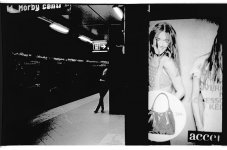arnulf
Registered User
Sort of a follow-up from a previous thread:
I am really deeply impressed with my new Nikon Coolscan V. Especially the Digital ICE feature. It removes pretty much all the dust and scratches on my negatives. I have no idea how it does it, but it certainly works incredibly well.
That is: it all worked wonderfully until I started scanning my Tri-x negatives. Turning on the ICE totally messes up the picture. I've attached two images. One with ICE and one without. All other settings were the same on the scanning software.
So, what the hell is this all about? Is the ICE not working on B/W, or something?
I am really deeply impressed with my new Nikon Coolscan V. Especially the Digital ICE feature. It removes pretty much all the dust and scratches on my negatives. I have no idea how it does it, but it certainly works incredibly well.
That is: it all worked wonderfully until I started scanning my Tri-x negatives. Turning on the ICE totally messes up the picture. I've attached two images. One with ICE and one without. All other settings were the same on the scanning software.
So, what the hell is this all about? Is the ICE not working on B/W, or something?
Attachments
findwolfhard
Established
Ici
Ici
Hi ! Check the manual!
It just doesn`t work with B&W!
best regards Wolfhard
Ici
Hi ! Check the manual!
It just doesn`t work with B&W!
best regards Wolfhard
M. Valdemar
Well-known
It's can't work on b/w. The structure of the film is different.
That's what the instruction manual is included for.
That's what the instruction manual is included for.
oscroft
Veteran
As far as I know, Digital ICE works by using the transparency of the film to infrared light. The dyes in a colour image are transparent to IR, while dust spots are opaque to it. But with B&W, the silver grains that make up the image are also opaque to IR and so it can't tell the difference between the grains and dust. And thus Digital ICE doesn't work with B&W. (I don't know whether it will work with dye-based chromogenic B&W).
Rogrund
Antti Sivén
M. Valdemar said:It's can't work on b/w.
Silver base B/W, that is. As far as I know, ICE works perfectly on C41 B/W films like Kodak BW400CN and Ilford XP2.
That's what the instruction manual is included for.
And there's no need to be condescending by referring to manuals and stuff like that. We can just help each other, right?
arnulf
Registered User
Ok, sorry guys! I guess I should have read the manual more thoroughly first. Thanks for your quick answers anyway.
maddoc
... likes film again.
oscroft said:As far as I know, Digital ICE works by using the transparency of the film to infrared light. The dyes in a colour image are transparent to IR, while dust spots are opaque to it. But with B&W, the silver grains that make up the image are also opaque to IR and so it can't tell the difference between the grains and dust. And thus Digital ICE doesn't work with B&W. (I don't know whether it will work with dye-based chromogenic B&W).
It works with chromogenic B&W (XP2, BW400CN).
craygc
Well-known
The damn Nikon 9000 behaves the same... imagine how depressing it is to have to manually clean a 6x7 neg 
arnulf
Registered User
Ok, now for another follow-up question:
Could someone direct me to a thread that deals with cleaning of negatives? What should one do in order to free them of drying marks and dust without damaging them?
Could someone direct me to a thread that deals with cleaning of negatives? What should one do in order to free them of drying marks and dust without damaging them?
Tuolumne
Veteran
I use compressed air - gently and at an angle. Seems to work best. Also, keep a clean work area (as if I do!).
/T
/T
arnulf
Registered User
Thanks a lot, Tuolumne.
But what about drying marks? Should I just clean them in water (very carefully, of course!!) and dry them again, or is there a better way?
But what about drying marks? Should I just clean them in water (very carefully, of course!!) and dry them again, or is there a better way?
Sparrow
Veteran
arnulf said:Ok, now for another follow-up question:
Could someone direct me to a thread that deals with cleaning of negatives? What should one do in order to free them of drying marks and dust without damaging them?
Moving to a soft-water area helps with the drying marks, dust is right up there with death and tax, unavoidable sadly. A compressor and blow gun is my weapon of choice.
bmattock
Veteran
I recently cleaned up a couple of negatives with - dare I say it - q-tips and alcohol. I was afraid it would do some damage to the film, but it was n the nature of an experiment. Worked. Did not seem to damage the emulsion at all. I should add that it was B&W I had processed myself, and used Kodak Quick fix, which has hardener. That may have helped keep me from destroying it. I buffed out the drying marks on the non-emulsion side with a clean lens cloth and my breath. Perhaps not the wisest course of action - but it worked!
kipkeston
Well-known
arnulf said:Thanks a lot, Tuolumne.
But what about drying marks? Should I just clean them in water (very carefully, of course!!) and dry them again, or is there a better way?
Your film will get drying marks again if you just use water. I would get some photo-flo, in which the secret is really alcohol! Just rewash and use some of the f-flo.
To fight dust scanning, I have some Kalt white gloves, I run the strip between my ringers before jamming it in to the n*kon
Last edited:
Gradskater
Well-known
If you are using silverfast the iSRD software should work for you. It takes some time to work with it, but the results can be pretty amazing. I have an example of a scratched and fixed color picture somewhere on my flickr page.
sirius
Well-known
After you rinse with photo-flo it helps to run your fingers down to get excess water off. I got this tip after finding the professional squeegee scratched my negs and left water stains around the sprocket holes sometimes. I'm a beginner myself...
bmattock
Veteran
kipkeston said:Your film will get drying marks again if you just use water. I would get some photo-flo, in which the secret is really alcohol!
Beg pardon, but I think that the secret is not alcohol as such.
Photo-flo is mostly propylene glycol, which yes, is an 'alcohol', but not like most of us non-chemists think of alcohol. It is oily and has other properties of a lubricant such as changing the surface tension of water.
Water beads up - you see it when you wax your car and it gets wet. Beading is not good - where the water cannot spread out, it takes longer to evaporate due to less surface exposure to air, and when it does evaporate, it leaves whatever impurities were in the water on one place in the film. On a car, we call those 'water spots'.
There are three basic ways to avoid water spots on film while it dries.
The first is to remove all water. However, one runs the risk of scratching the film with agressive squeegee action, and in addition, there is water in the gelatin emulsion that must dry out more slowly.
The second is to use water that has no mineral or other impurities to leave marks behind. This can be done, but can be prohibitively expensive, given the amount of washing that film needs to get all the fixer out of the film's emulsion.
The third is to cause the water to lose its surface tension, so it does not 'bead up'. This makes it spread out. Part of it will flow off the film entirely, and since it is spreading out, it will evaporate more quickly, since it is exposed to the air over a larger surface area. It will leave deposits behind, but not along a line marked by the edges of a 'bead' of water. So you won't really see them.
Hope that helps. I could be wrong, but this is my understanding of Photo-flo.
By the way, I find I prefer LFN these days to Photo-flo 2000.
gertf
Established
I use a final rinse of distilled water when developing. Have not had any problems since
arnulf
Registered User
Really? That simple? Interesting! So, how long do you rinse it? Do you use wetting agent before that?
Ronald_H
Don't call me Ron
I found the wisdom here that a wetting agent is nothing more than a mild detergent (like washing up liquid). I do one tiny drop in my final rinse and voila... al of my staining has gone.
A friend who just started doing a photography course was give the same advice. It works and costs nothing.
A friend who just started doing a photography course was give the same advice. It works and costs nothing.
Share:
-
This site uses cookies to help personalise content, tailor your experience and to keep you logged in if you register.
By continuing to use this site, you are consenting to our use of cookies.


